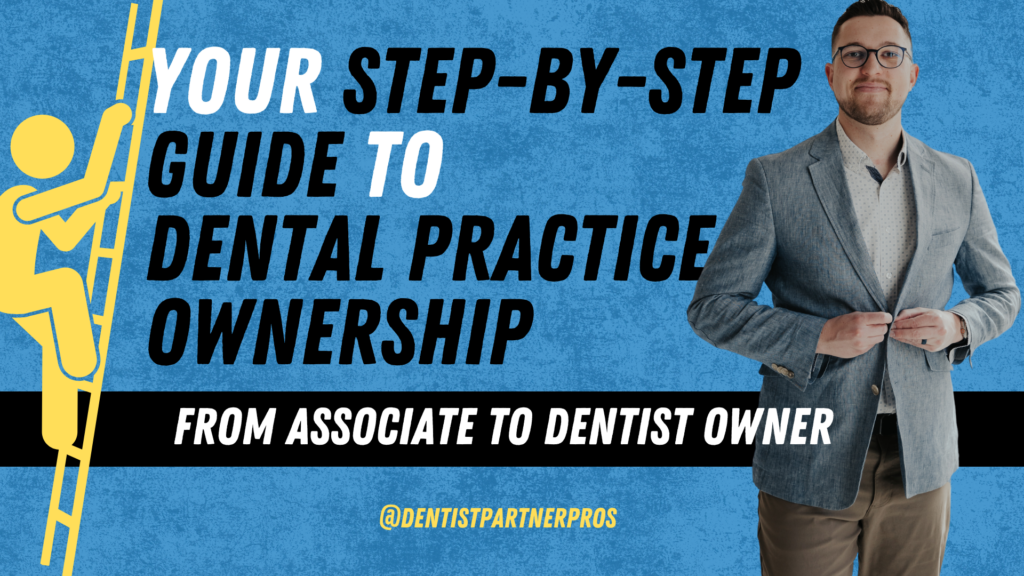
For many associate dentists, practice ownership is the ultimate career goal. It’s an exciting opportunity to take control of your future, build wealth, and create a practice that reflects your values.
However, the transition from associate to owner can feel overwhelming. How do you prepare financially? Where do you start the process? How do you avoid common pitfalls?
In this article, we’ll break down the step-by-step guide to dental practice ownership—helping you navigate this journey with confidence.
1. Understand the “Why”: Is Ownership Right for You?
Before jumping into ownership, it’s essential to ask yourself why you want to own a practice. Ownership comes with immense rewards but also significant responsibilities.
Reflect on These Questions:
- Do you enjoy leadership and managing a team?
- Are you ready for the financial commitment and risk of ownership?
- Does creating a long-term vision for a practice excite you?
Why It Matters:
Clarifying your “why” ensures you approach ownership with the right mindset. It also helps you remain focused when challenges arise during the transition.
2. Financial Preparation: Know Your Numbers
Owning a dental practice requires financial readiness. Start by assessing your current financial situation and determining what you can afford.
Key Steps:
- Build Your Credit: A strong credit score will help you secure loans with better terms.
- Save for the Transition: Lenders often require a down payment, typically 10-20% of the practice’s value.
- Review Your Debt-to-Income Ratio: Pay down personal debts where possible to strengthen your financial profile.
Action Tip: Partner with a dental CPA or financial advisor to develop a realistic plan for practice ownership. They’ll help you evaluate loan options, forecast expenses, and ensure you’re prepared for success.
3. Find the Right Practice: It’s About Fit, Not Just Price
When searching for a practice to purchase, it’s easy to focus on price alone. However, a successful acquisition hinges on finding a practice that aligns with your goals and values.
Factors to Evaluate:
- Location: Is it in an area where you’d enjoy living and working?
- Patient Base: What’s the practice’s case mix—family dentistry, cosmetic, Medicaid, etc.?
- Financial Health: Review the practice’s revenue, overhead, and profit margins.
- Culture and Team Dynamics: Will you inherit a team that aligns with your leadership style?
Action Tip: Work with a trusted dental consultant to help identify and vet potential practices. A professional’s insights can save you time, stress, and costly mistakes.
4. Perform Due Diligence: Look Before You Leap
Once you’ve identified a potential practice, the next step is performing due diligence—a deep dive into the practice’s operational and financial details.
Key Areas to Review:
- Financial Records: Verify revenue, expenses, and profitability.
- Equipment and Facility: Assess the condition of dental equipment and the lease or property agreement.
- Team Structure: Review team roles, compensation, and contracts.
- Patient Data: Analyze patient retention rates, active patient counts, and insurance participation.
Why It Matters:
Thorough due diligence helps you avoid unexpected surprises after purchase.
5. Plan for a Smooth Transition
Ownership transitions can impact team morale and patient retention if not handled thoughtfully. A well-structured plan ensures a seamless change for everyone involved.
Key Elements of a Transition Plan:
- Communication: Meet with the current team to share your vision and reassure them about the future.
- Training and Onboarding: Understand how the previous owner ran the practice and adapt processes gradually.
- Patient Retention Strategy: Send letters introducing yourself to patients and emphasize continuity of care.
Action Tip: If the current owner is staying on for a transition period, use this time to build relationships with the team and patients. Learn what works well in the practice before making major changes.
6. Develop Your Leadership Skills
Owning a practice means stepping into a leadership role. To succeed, you need to inspire your team, manage operations, and create a thriving workplace culture.
Leadership Tips for New Owners:
- Foster open communication and build trust with your team.
- Create clear expectations and systems for accountability.
- Invest in ongoing training and professional growth for yourself and your team.
Remember: Great leaders listen, empower their teams, and lead by example.
7. Set Yourself Up for Long-Term Success
The first year of ownership is about laying the foundation for growth. Focus on building efficient systems, growing your patient base, and keeping your team aligned with your vision.
Actionable Steps:
- Optimize your scheduling, billing, and patient communication systems.
- Focus on patient retention and word-of-mouth referrals to grow the practice.
- Track your numbers—monitor revenue, overhead, and production goals regularly.
Action Tip: Partner with a consultant who specializes in dental practice management. They’ll help you streamline systems, hire the right people, and set a clear roadmap for long-term success.
The Benefits of Owning Your Practice
While the road to ownership requires effort, the rewards are well worth it:
✅ Control over your career and future.
✅ Greater financial independence and long-term wealth.
✅ The opportunity to create a practice that reflects your vision and values.
Whether you’re just starting to dream about ownership or you’re ready to take the leap, know this: with the right preparation and mindset, you can succeed.
Ready to Make the Transition to Ownership?
At Dentist Partner Pros, we specialize in guiding associate dentists through every stage of practice ownership. From financial planning and practice acquisition to team management and growth strategies, we help you achieve your goals with confidence.
👉 Schedule a free consultation today, and let’s map out your journey to becoming a practice owner!
What’s Holding You Back?
Are you considering practice ownership but unsure where to start? Share your questions or concerns in the comments below—I’d love to help you navigate the path to success!